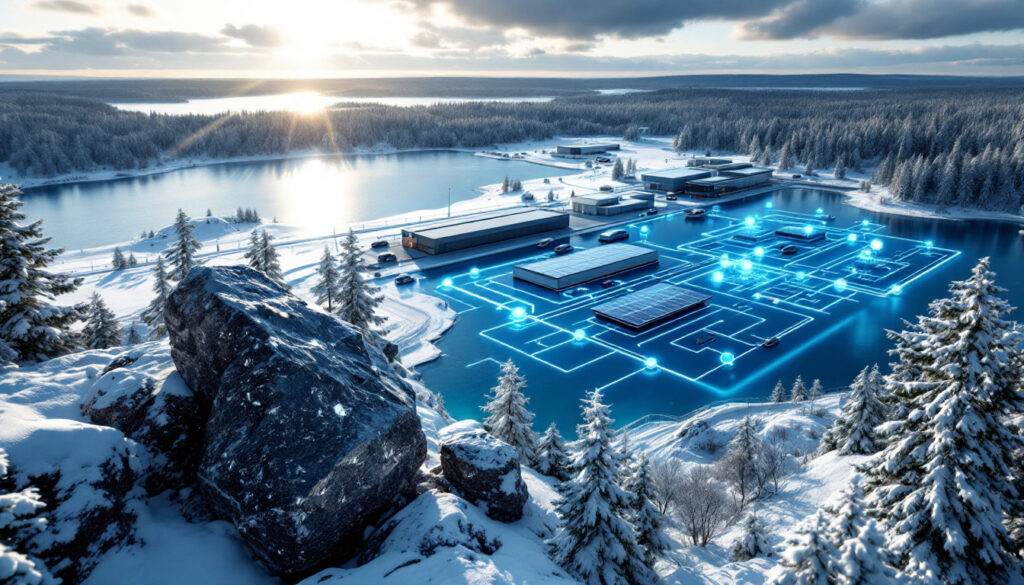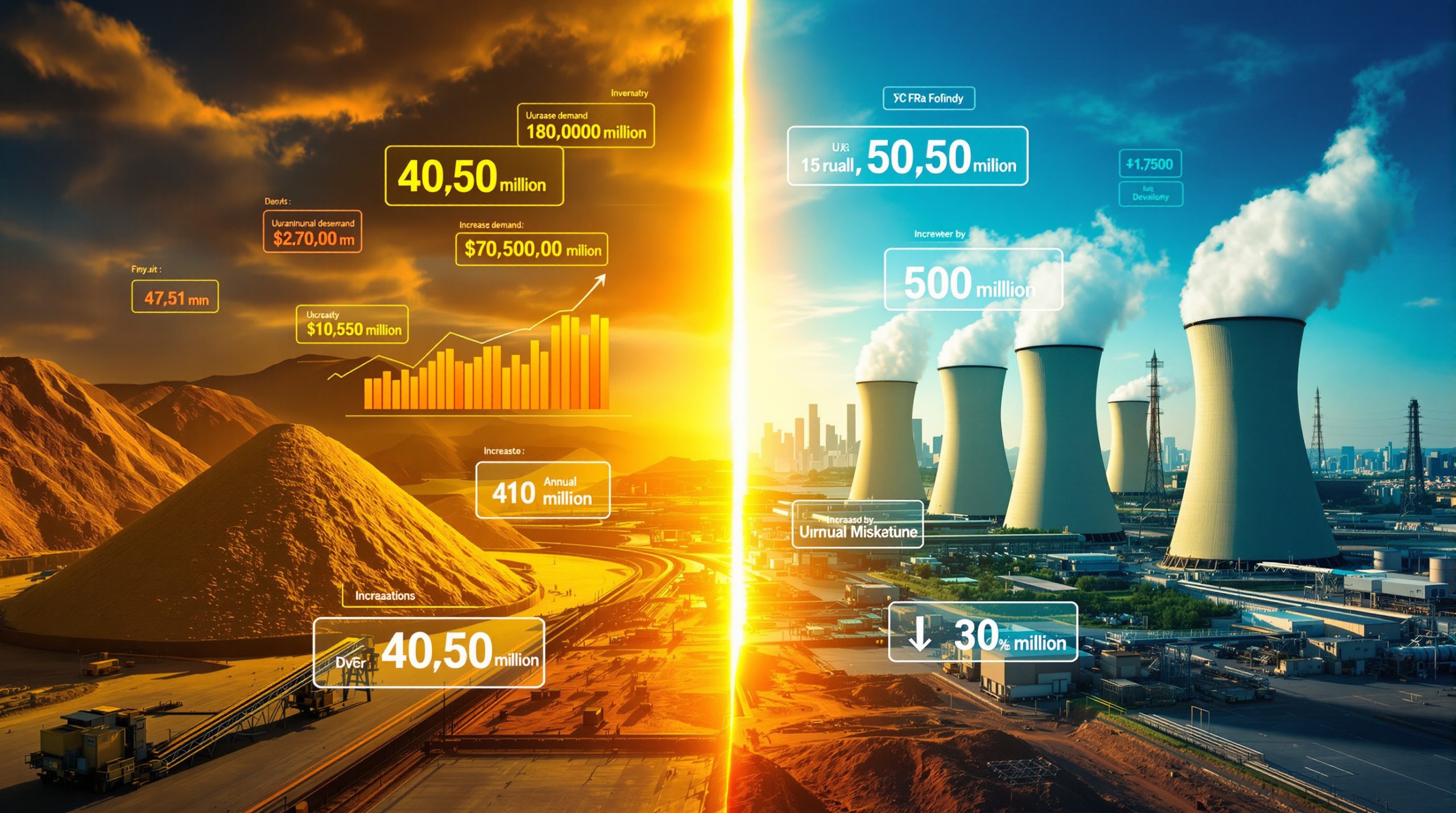What is the Vittangi Graphite Project? Understanding Talga's Strategic Partnership with Worley
The Vittangi Graphite Project stands as a groundbreaking initiative in northern Sweden that aims to establish Europe's first large-scale integrated graphite mine and battery anode production facility. This pioneering venture represents a critical step toward reducing Europe's dependence on imported battery materials, particularly from China, which currently dominates global graphite processing.
The strategic partnership between Talga Group and Worley, formalized through a non-binding Letter of Intent (LOI) in May 2025, lays the groundwork for a comprehensive Engineering, Procurement, and Construction Management (EPCM) contract. This collaboration leverages Worley's extensive experience in critical mineral shortages processing alongside Talga's innovative graphite production technologies.
With graphite being the largest component by weight in lithium-ion batteries (comprising up to 95% of the anode), the Vittangi project addresses a crucial supply gap in Europe's rapidly expanding electric vehicle ecosystem. The high-grade graphite deposit at Vittangi, featuring exceptional 24.8% carbon content—nearly four times the global average—makes it one of the highest-quality graphite resources worldwide.
How Will the Talga-Worley Partnership Transform Europe's Battery Supply Chain?
The Strategic EPCM Contract Framework
The non-binding LOI represents a significant milestone, establishing the framework for a future binding EPCM contract contingent on Talga's Final Investment Decision (FID). This conditional implementation approach allows both parties to align their strategic objectives while managing project risks effectively.
The agreement includes specific timeline parameters, with the LOI set to expire on April 10, 2026, unless both companies agree to extend this deadline. This structured timeline creates accountability and momentum toward project implementation.
Pre-FID activities have already commenced, with collaborative teams working to finalize critical preparatory engineering work, equipment specifications, and construction planning. These activities ensure a seamless transition to full-scale implementation once the FID is secured.
Talga CEO Martin Phillips emphasized the significance of this partnership: "Securing an experienced EPCM partner with Worley's capabilities marks a crucial step in our journey to deliver European-made battery materials. Their technical expertise will be instrumental in bringing our vertically integrated facility online efficiently and sustainably."
Worley's Established Project Involvement
Worley brings substantial value through its long-term collaboration with Talga, having provided specialized engineering services since 2019 across multiple project development phases. This continuity ensures valuable institutional knowledge transfers throughout the project lifecycle.
The company's technical expertise in critical minerals processing has already contributed significantly to optimizing the project's processing flowsheets and equipment specifications. Their involvement in Europe's emerging battery materials sector includes several high-profile projects that have successfully navigated complex regulatory environments.
Through progressive engineering development across various mining feasibility insights, Worley has demonstrated its capability to adapt technical solutions to evolving market requirements and sustainability standards. This adaptive approach has resulted in process improvements that enhance both economic and environmental outcomes.
Beyond technical services, Worley offers valuable financing facilitation capabilities through its established relationships with international financial institutions and export credit agencies. These connections complement Talga's existing funding arrangements and could potentially unlock additional capital sources.
What Makes Vittangi a Strategic Asset for European Battery Production?
EU Strategic Designations and Regulatory Support
The Vittangi graphite mine has received the coveted Strategic Project designation under the EU's Critical Raw Materials Act, recognizing its essential role in securing Europe's battery materials supply chain. This designation accelerates permitting processes and provides preferential access to financing instruments.
Similarly, the battery anode plant component has secured strategic classification under the Net-Zero Industry Act, further cementing its importance within Europe's clean energy transition framework. These dual recognitions position the project as a cornerstone of the EU's industrial strategy.
From a supply chain perspective, the Vittangi project addresses a critical vulnerability in Europe's battery manufacturing ecosystem, currently over-dependent on imported materials. With the EU targeting 25% self-sufficiency in critical raw materials by 2030, Vittangi represents a significant contributor to this goal.
The regulatory advantages stemming from these designations include expedited permitting pathways, reducing administrative timelines by approximately 50% compared to standard procedures. This acceleration proves crucial in meeting Europe's rapidly growing demand for battery materials.
Secured Funding Mechanisms
The project has already secured a substantial €70 million ($79.7 million) grant from the EU Innovation Fund, demonstrating strong institutional support for its environmental and technological merits. This non-dilutive funding significantly improves the project's economics.
Additionally, the European Investment Bank has committed €150 million as a cornerstone investment, anchoring a broader debt financing package. This backing from Europe's premier public financial institution validates the project's strategic importance and economic viability.
The EIB commitment serves as the foundation for a structured debt consortium that will likely include commercial banks, export credit agencies, and specialized green finance providers. This diversified funding approach mitigates financial risks while optimizing capital costs.
Project financing timelines have been strategically aligned with development milestones, ensuring capital deployment synchronizes with construction phases and equipment procurement schedules. This coordination optimizes cash flow management during the capital-intensive implementation period.
How Does the Vittangi Project Advance Sustainable Battery Production?
Integrated Production Approach
The project's mine-to-battery integration represents a paradigm shift from conventional fragmented supply chains, eliminating multiple transportation legs and intermediate processing steps. This vertical integration reduces both costs and environmental impacts.
Talga's innovative processing technology delivers low-emission graphite solutions with a carbon footprint approximately 80% lower than conventional Chinese-processed graphite. Life cycle assessments indicate that Vittangi's anode material will produce just 1.9kg CO2e per kg, compared to the industry average of 17kg CO2e per kg.
The European production footprint eliminates approximately 11,000 nautical miles of transportation compared to traditional China-processed graphite, reducing embodied carbon while improving supply chain resilience and traceability. This localized approach aligns with the EU's carbon border adjustment mechanism.
Sustainable processing technologies employed at Vittangi include water recycling systems capturing over 90% of process water, energy-efficient grinding circuits, and zero-chemical mechanical purification methods. These innovations establish new industry benchmarks for environmentally responsible manufacturing.
Technical Production Capabilities
The Nunasvaara South mine forms the raw material foundation of the project, featuring graphite with exceptional crystallinity and electrical conductivity ideally suited for battery applications. The deposit's thickness and near-surface location enable efficient extraction with minimal waste material.
The anode material processing facility employs Talga's proprietary technology for converting natural graphite into battery-grade coated anode products without the energy-intensive thermal purification methods typically used in China. This approach reduces energy consumption by approximately 65% compared to conventional methods.
Production specifications meet the exacting quality requirements established by leading European EV manufacturers, with performance characteristics including high initial capacity (355-365 mAh/g), excellent cycle life (>1,000 cycles at 80% capacity), and fast-charging capabilities. These specifications exceed industry standards for automotive-grade materials.
The project's scale considerations factor in Europe's projected demand growth, with initial production capacity of 19,500 tonnes annually of anode material—sufficient to power approximately 375,000 electric vehicles. The facility design incorporates expansion potential to double capacity as market demand increases.
What are the Project Implementation Milestones and Requirements?
Path to Final Investment Decision
Securing customer supply agreements represents a critical prerequisite for the FID, with Talga already announcing non-binding offtake agreements covering approximately 60% of initial production capacity. These arrangements include several European battery manufacturers and automotive OEMs.
The financing structure completion path involves finalizing terms with the EIB-led consortium, securing additional equity contributions, and potentially leveraging export credit guarantees from Swedish and Australian government agencies. This diversified approach optimizes capital costs while distributing risk.
Technical readiness verification includes completing detailed engineering design packages, confirming equipment specifications with vendors, and finalizing construction methodologies suited to northern Sweden's challenging climate conditions. These technical validations ensure execution certainty.
The Board approval process involves comprehensive governance reviews of technical, financial, environmental, and market factors before authorizing the approximately €600 million total capital expenditure. This rigorous evaluation ensures the project meets Talga's strategic objectives and shareholder expectations.
EPCM Service Scope
Worley's engineering services coverage extends from detailed plant design to electrical systems integration, infrastructure development, and process control systems. Their specialized experience in mineral processing facilities operating in arctic conditions proves particularly valuable for this northern Swedish location.
The procurement management strategy focuses on identifying long-lead equipment items, securing supply chain commitments, and implementing supplier qualification programs that emphasize sustainability metrics alongside traditional cost and quality parameters. This approach ensures responsible sourcing throughout the value chain.
Construction oversight responsibilities include managing multiple contractor interfaces, implementing advanced project controls, and coordinating commissioning activities. Worley's expertise in modular construction techniques will be employed to mitigate the challenges of building in remote northern Sweden.
The comprehensive project controls system integrates schedule management, cost monitoring, and quality assurance protocols within a digitalized platform that provides real-time performance visibility to all stakeholders. This transparency facilitates prompt decision-making and risk mitigation.
What are the Broader Implications for Battery Supply Chains?
European Battery Industry Development
The project advances supply chain localization objectives, potentially reducing Europe's imported graphite dependency by up to 20% when operating at full capacity. This self-sufficiency enhancement aligns with the European Battery Alliance's strategic goals.
Strategic autonomy enhancements extend beyond physical material supplies to encompass technological independence through Talga's proprietary processing methods. This intellectual property creates a sustainable competitive advantage for European battery manufacturing.
The manufacturing ecosystem benefits include potential co-location opportunities for additional battery component producers, creating a northern European battery materials hub. Several cathode material producers have already expressed interest in establishing operations near the Vittangi facility.
Competitive positioning improvements against Asian battery manufacturers stem from shortened supply chains, reduced logistics costs, and enhanced sustainability credentials. These advantages translate into an estimated 7-12% cost advantage for European EV manufacturers sourcing locally.
Market Impact Analysis
The project contributes to supply diversification effects by introducing a significant new source of battery-grade graphite outside the dominant Chinese production sphere. This diversification moderates market concentration risk and potential supply disruptions.
Pricing implications could include greater stability in European anode material costs, reducing exposure to Chinese export policies and freight rate volatility. Industry analysts project that localizing production could reduce total anode costs by approximately €300-450 per electric vehicle.
Quality differentiation represents a key competitive advantage, with Vittangi's graphite demonstrating superior performance characteristics, including faster charging capabilities and extended cycle life compared to standard Chinese material. These performance benefits enhance the value proposition for premium automotive applications.
Supply security enhancement addresses a critical vulnerability in Europe's industrial strategy, with graphite identified by the EU as facing the highest supply risk among battery materials. The project's domestic production provides a strategic buffer against geopolitical supply disruptions.
How Does the Project Align with European Green Transition Goals?
Environmental and Sustainability Considerations
The project's carbon footprint reduction strategy incorporates renewable energy utilization, process efficiency optimizations, and transportation emissions elimination. These combined measures result in a greenhouse gas reduction of approximately 2.5 million tonnes over ten years compared to imported materials.
Renewable energy integration leverages Sweden's exceptionally clean electricity grid (97% carbon-free), with additional plans for on-site solar generation to further reduce emissions. The facility's power purchase agreements specify 100% certified renewable electricity.
Water management practices include closed-loop systems that recycle approximately 95% of process water, significantly reducing freshwater consumption compared to conventional operations. Advanced filtration technologies ensure discharged water meets or exceeds stringent Swedish environmental standards.
Land use optimization techniques minimize the project's physical footprint through efficient facility design and underground mining methods that reduce surface disturbance. The site rehabilitation plan includes progressive restoration and biodiversity enhancements to leave a positive environmental legacy.
Regulatory Compliance Framework
The environmental permitting status has progressed systematically through Sweden's rigorous assessment process, with final approvals anticipated in late 2025. The comprehensive environmental impact assessment addressed groundwater protection, air quality, biodiversity conservation, and cultural heritage preservation.
Social license considerations remain central to the project's development approach, with extensive consultation processes involving local communities, indigenous Sami representatives, and regional authorities. These engagements have shaped project design modifications and community benefit agreements.
ESG challenges and opportunities will be monitored through an integrated reporting framework aligned with the Global Reporting Initiative and Task Force on Climate-related Financial Disclosures standards. These metrics include energy intensity, water consumption, community employment, and carbon emissions.
The project's alignment with EU taxonomy classification for sustainable investments enhances its attractiveness to ESG-focused investors and green bond issuances. This classification validates that the project's environmental credentials meet Europe's highest sustainability standards.
What Are the Key Project Statistics and Technical Details?
Project Specifications and Parameters
The exploitation concession secured for Nunasvaara South covers approximately 176 hectares and contains graphite resources sufficient for more than 25 years of production at planned rates. The high-grade resource (24.8% carbon content) enables efficient processing with minimal waste generation.
Production capacity targets include 19,500 tonnes annually of battery-grade anode material in the initial phase, with expansion potential to 36,000 tonnes by 2030. This output would satisfy approximately 16-20% of projected European demand by decade's end.
Processing technology selection features Talga's proprietary mechanical purification system, which achieves 99.95% carbon purity without the chemical leaching or high-temperature thermal treatments typically used in conventional processing. This innovative approach significantly reduces both energy consumption and environmental impacts.
Infrastructure requirements include dedicated power transmission lines, water treatment facilities, and transportation linkages to nearby rail networks and ports. The project benefits from Sweden's well-developed infrastructure, though some upgrades to regional roads and power distribution will be necessary.
Timeline and Development Schedule
The EPCM contract implementation will commence immediately following a positive FID by Talga's Board, anticipated in Q4 2025. Early works and site preparation activities may begin earlier under separate authorization to optimize the construction schedule.
Construction phase planning divides the implementation into distinct packages, beginning with site preparation and infrastructure development, followed by process plant construction and mining development. This phased approach optimizes resource allocation while managing seasonal construction constraints in northern Sweden.
Commissioning targets project first production of battery-grade anode material by mid-2027, with full production capacity achieved approximately 12 months later. This timeline aligns with projected European battery gigafactory expansions scheduled for 2027-2028.
The production ramp-up strategy employs a phased approach to full capacity achievement, starting with basic anode material production before introducing more specialized high-performance products as operational stability is established. This graduated implementation reduces technical risk while building market presence.
FAQ About the Talga-Worley Vittangi Project Partnership
What is the significance of the EU Strategic Project designation?
The Strategic Project status under the EU's Critical Raw Materials Act provides Vittangi with prioritized permitting procedures, streamlined regulatory processes, and potential access to dedicated funding mechanisms. This designation recognizes the project's essential role in securing Europe's supply of critical battery materials. Additionally, it signals to investors and customers that the project has passed rigorous EU assessments regarding its strategic importance and feasibility.
How does this project compare to other graphite developments globally?
The Vittangi project distinguishes itself through its integrated approach combining mining and anode production in Europe, whereas most graphite supply chains involve extraction in Africa or Asia with processing predominantly in China. This European integration offers significant advantages in terms of supply security, carbon footprint, and quality control. Furthermore, Vittangi's exceptionally high grade (24.8% carbon) far exceeds typical graphite developments in East Africa (5-8%) and China (3-15%), enabling more efficient processing and lower production costs.
What makes Worley particularly suited for this EPCM contract?
Worley brings specialized expertise in critical minerals processing, a track record of involvement with the Vittangi project since 2019, and capabilities in facilitating financing solutions. Their global technical knowledge combined with experience in sustainable resource development aligns with Talga's vision for responsible battery material production. Additionally, Worley's successful implementation of similar facilities operating in cold-climate conditions provides valuable experience for managing construction and operations in northern Sweden's challenging environment.
How will this project impact European EV manufacturing?
By establishing a local supply of battery-grade graphite anode material, the project addresses a critical gap in Europe's EV supply chain. This localization reduces dependency on imports, potentially improves supply security, and helps European automakers meet increasingly stringent local content requirements for battery components. Industry analysis suggests that securing domestic anode material could accelerate European EV production by reducing battery manufacturing bottlenecks while simultaneously improving sustainability credentials that increasingly drive consumer purchasing decisions.
Further Exploration:
Readers interested in learning more about developments in European battery material supply chains can also explore related educational content from Mining Technology's coverage of Talga's Vittangi project or review our comprehensive mining investment guide for insight into the evolving battery materials sector.
The continued advancement of digital transformation in mining will likely play a crucial role in Talga and Worley's efficient implementation of
Want to Profit from the Next Major Mineral Discovery?
Discovery Alert's proprietary Discovery IQ model instantly notifies investors about significant ASX mineral discoveries, delivering actionable insights ahead of the market. Understand why historic discoveries like Talga can generate substantial returns by visiting Discovery Alert's dedicated discoveries page and begin your 30-day free trial today.




